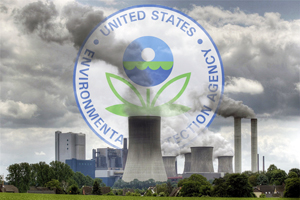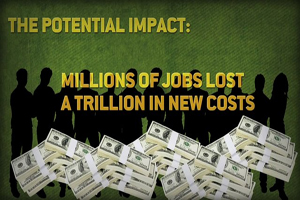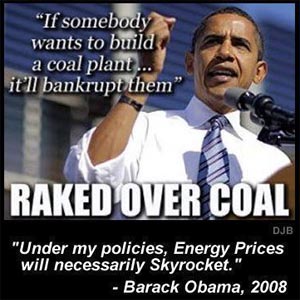 Led by U.S. Senate Majority Leader Mitch McConnell (R-Ky.), Senate Environment and Public Works Committee Chairman Jim Inhofe (R-Okla.), House Energy and Commerce Committee Chairman Fred Upton (R-Mich.) and House Energy and Power Subcommittee Chairman Ed Whitfield (R-Ky.), 34 Senators and 171 House Members including Tulsa’s Rep. Jim Bridenstine (R-OK) filed an amicus brief today in the case of State of West Virginia, et al. v. Environmental Protection Agency, et al.
Led by U.S. Senate Majority Leader Mitch McConnell (R-Ky.), Senate Environment and Public Works Committee Chairman Jim Inhofe (R-Okla.), House Energy and Commerce Committee Chairman Fred Upton (R-Mich.) and House Energy and Power Subcommittee Chairman Ed Whitfield (R-Ky.), 34 Senators and 171 House Members including Tulsa’s Rep. Jim Bridenstine (R-OK) filed an amicus brief today in the case of State of West Virginia, et al. v. Environmental Protection Agency, et al.
The amicus brief is in support of petitions filed by 27 states seeking to overturn the EPA final rule identified as the Carbon Pollution Emission Guidelines for Existing Stationary Sources: Electric Utility Generating Units, EPA-HQ-OAR-2013-0602, 80 Fed. Reg. 64,662 (Oct. 23, 2015), also known as the “Clean Power Plan.” A copy of the brief can be found here.
As Senators and Representatives duly elected to serve in the Congress of the United States in which “all legislative Powers” granted by the Constitution are vested, the members state that:
 The Final Rule goes well beyond the clear statutory directive by, among other things, requiring States to submit, for approval, state or regional energy plans to meet EPA’s predetermined CO2 mandates for their electricity sector. In reality, if Congress desired to give EPA sweeping authority to transform the nation’s electricity sector, Congress would have provided for that unprecedented power in detailed legislation. Indeed, when an agency seeks to make “decisions of vast ‘economic and political significance’” under a “long-extant statute,” it must point to a “clear” statement from Congress. Util. Air Regulatory Grp. v. EPA, 134 S. Ct. 2427, 2444 (2014) (quoting FDA v. Brown & Williamson Tobacco Corp., 529 U.S. 120, 160, 529 U. S. Ct. 1291, 1315 (2000)). EPA can point to no statement of congressional authorization for the Final Rule’s central features, precisely because there is none.
The Final Rule goes well beyond the clear statutory directive by, among other things, requiring States to submit, for approval, state or regional energy plans to meet EPA’s predetermined CO2 mandates for their electricity sector. In reality, if Congress desired to give EPA sweeping authority to transform the nation’s electricity sector, Congress would have provided for that unprecedented power in detailed legislation. Indeed, when an agency seeks to make “decisions of vast ‘economic and political significance’” under a “long-extant statute,” it must point to a “clear” statement from Congress. Util. Air Regulatory Grp. v. EPA, 134 S. Ct. 2427, 2444 (2014) (quoting FDA v. Brown & Williamson Tobacco Corp., 529 U.S. 120, 160, 529 U. S. Ct. 1291, 1315 (2000)). EPA can point to no statement of congressional authorization for the Final Rule’s central features, precisely because there is none.
 Nor has Congress authorized EPA to make the policy choices that are reflected in the Final Rule—a rule that imposes enormous costs on States and the public without achieving meaningful climate benefits. Because of the Final Rule, States will face unprecedented new regulatory burdens, electricity ratepayers will be subject to billions of dollars in compliance costs, and American workers and their families will experience the hardship of job losses due to power plant shutdowns, higher electricity prices, and overall diminishment of the nation’s global economic competitiveness. Choices of this nature are inherently Congressional decisions. See W. Minn. Mun. Power Agency v. Fed. Energy Regulatory Comm’n, 806 F.3d 588, 593 (D.C. Cir. 2015) (“Agencies are empowered to make policy only insofar as Congress expressly or impliedly delegates that power.”) (citing Util. Air Regulatory Grp., 134 S. Ct. at 2445 (2014)). Congress has not authorized EPA to make the central policy choices in the Final Rule and, in many respects, has affirmatively rejected those policies, as it certainly did with respect to cap-and-trade programs for CO2 emissions from power plants.
Nor has Congress authorized EPA to make the policy choices that are reflected in the Final Rule—a rule that imposes enormous costs on States and the public without achieving meaningful climate benefits. Because of the Final Rule, States will face unprecedented new regulatory burdens, electricity ratepayers will be subject to billions of dollars in compliance costs, and American workers and their families will experience the hardship of job losses due to power plant shutdowns, higher electricity prices, and overall diminishment of the nation’s global economic competitiveness. Choices of this nature are inherently Congressional decisions. See W. Minn. Mun. Power Agency v. Fed. Energy Regulatory Comm’n, 806 F.3d 588, 593 (D.C. Cir. 2015) (“Agencies are empowered to make policy only insofar as Congress expressly or impliedly delegates that power.”) (citing Util. Air Regulatory Grp., 134 S. Ct. at 2445 (2014)). Congress has not authorized EPA to make the central policy choices in the Final Rule and, in many respects, has affirmatively rejected those policies, as it certainly did with respect to cap-and-trade programs for CO2 emissions from power plants.
 Accordingly, the Final Rule that has been properly stayed by the Supreme Court should now be vacated by this Court.
Accordingly, the Final Rule that has been properly stayed by the Supreme Court should now be vacated by this Court.
Additional Information: Thirty-nine lawsuits seeking review of the Final Rule have been consolidated in the D.C. Circuit. The Final Rule was stayed by the Supreme Court on Feb. 9. The D.C. Circuit is scheduled to hear oral arguments in the consolidated cases on June 2. An amicus brief, or “friend of the court” brief, can be filed in order to address concerns and advise the Court on a matter of law that directly affects the case at hand.
